
Paper wasps are vespid wasps and typically refers to members of the vespid subfamily Polistinae, though it often colloquially includes members of the subfamilies Vespinae and Stenogastrinae, discussed elsewhere, which also make nests out of paper. Paper wasp nests are characterized by open combs with down pointing cells. Some types of paper wasps are also sometimes called umbrella wasps, due to the distinctive design of their nests.

Polistes is a cosmopolitan genus of paper wasps and the only genus in the tribe Polistini. Vernacular names for the genus include umbrella wasps, coined by Walter Ebeling in 1975 to distinguish it from other types of paper wasp, in reference to the form of their nests, and umbrella paper wasps. Polistes is the single largest genus within the family Vespidae, with over 200 recognized species. Their innate preferences for nest-building sites leads them to commonly build nests on human habitation, where they can be very unwelcome; although generally not aggressive, they can be provoked into defending their nests. All species are predatory, and they may consume large numbers of caterpillars, in which respect they are generally considered beneficial.

Cicada killer wasps are large, solitary, ground-dwelling, predatory wasps. They are so named because they hunt cicadas and provision their nests with them, after stinging and paralyzing them. Twenty-one species worldwide are recognized. The highest diversity occurs in the region between North Africa and Central Asia.
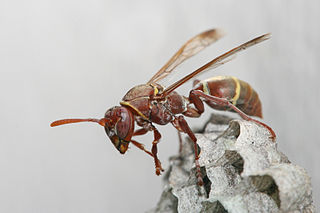
The Polistinae is a subfamily of eusocial wasps belonging to the family Vespidae. They are closely related to the wasps and true hornets of the subfamily Vespinae, containing four tribes. With about 1,100 species total, it is the second-most diverse subfamily within the Vespidae, and while most species are tropical or subtropical, they include some of the most frequently encountered large wasps in temperate regions.

Chalcoela iphitalis, the sooty-winged chalcoela, is a moth species of the family Crambidae that occurs throughout North America. They are seen as far south as California, Arizona and South Carolina and as far north as Ontario. Adults can be seen from May to August. The head, body and front portion of the forewings are yellow-orange while the hindwing and back portion of the forewings are grey and silver. The back edge of the hindwing has black spots.

Polistes carnifex, commonly known as the executioner wasp or executioner paper wasp, is a neotropical vespid wasp in the cosmopolitan genus Polistes.

Polistes carolina is one of two species of red paper wasp found in the eastern United States and is noted for the finer ridges on its propodeum. It is a social wasp in the family Vespidae and subfamily Polistinae. The species is native to the United States from Texas to Florida, north to New York, and west to Nebraska. The wasp's common name is due to the reddish-brown color of its head and body. P. carolina prefer to build their nests in protected spaces.

Polistes pacificus is a Neotropical species of social paper wasp belonging to the subfamily Polistinae and the family Vespidae. P. pacificus can be found distributed throughout most of Central and South America and parts of southern North America. First discovered by Johan Christian Fabricius in 1804, P. pacificus is much darker in color than some other more recognizable Polistes wasps, and is one of the insects commonly eaten by several indigenous groups in Venezuela and Colombia.
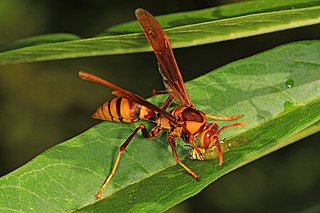
Polistes major is a Neotropical species of paper wasp found from South America north into the southern United States. This species is known as avispa de caballo in the Dominican Republic.

Polistes apachus is a social wasp native to western North America. It is known in English by the common name Texas paper wasp, or southwestern Texas paper wasp. It has also been called the Apache wasp, perhaps first by Simmons et al. in California in 1948. Simmons et al. reported how in California P. apachus is often found in fig orchards where it is considered a pest species due to its aggressive attacks and painful stings on farm labourers during harvest time in September and October. It may sometimes also be found in other types of orchards or in vineyards, but in California it is also commonly found to establish nests in or on houses in urban areas in attics or under the eaves of buildings. It is a type of paper wasp, which is the common name for a type of wasp that uses a papery material to construct its nests.

Polistes japonicus is a eusocial paper wasp found in Japan. It was first described by Henri Louis Frédéric de Saussure in 1858. It is closely related to Polistes formosanus. This species lives in small colonies with few workers and a foundress queen. Nests of these wasps are sometimes used as a traditional medicine in Korea, China, and Japan.

Mischocyttarus mexicanus is a New World species of paper wasp that exhibits facultative eusocial behavior and includes at least two subspecies living in the southern United States and Central America. This social wasp species is a good model for studying the selective advantage of different nesting tactics within a single species. M. mexicanus females can form nests both as individuals and as members of a colony, and are even known to switch between these two nesting strategies throughout their life, which is an unusual phenomenon in the field of social biology. Individuals in a colony have particular social roles that are plastic, as opposed to rigid castes, and brood parasitism and usurpation have been observed between unrelated conspecifics. They nest in a variety of types of plants and human constructions, although they have most frequently been observed in palm trees, and they are known to interact with a number of other species as prey, competitors over resources, or foragers.

Parancistrocerus fulvipes also known by the common name potter wasp is a species of stinging wasp in the family Vespidae. This species' nesting sites include borings in wood, old mud dauber and Polistes nests, and abandoned burrows of ground-nesting bees, but it may also construct its own burrows in the ground. Prey includes caterpillars of Tortricidae, Nolidae, Chloephorinae, Crambidae, and Gelechiidae.
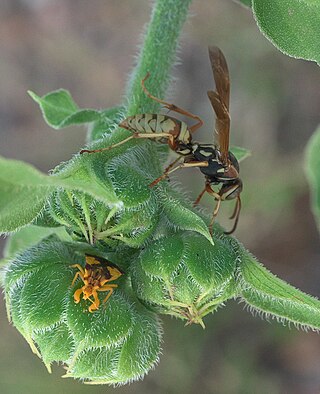
Polistes aurifer, the golden paper wasp, is a species of paper wasp in the genus Polistes of the family Vespidae. It occurs in the western part of North America, from southern Canada through the United States to northern Mexico.
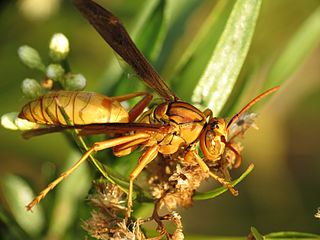
Polistes flavus, also known as the yellow paper wasp, is a species of paper wasp in the family Vespidae.
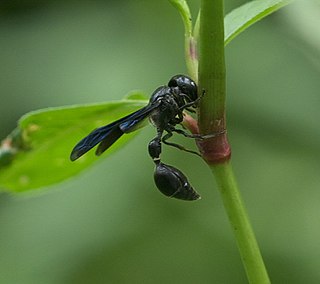
Zethus spinipes is a species of stinging wasp in the family Vespidae found in the eastern United States.

Polistes bahamensis is a large species of colourful paper wasp in the genus Polistes of the family Vespidae which occurs in the Bahamas, Florida and Louisiana. It is also said to occur in Georgia.
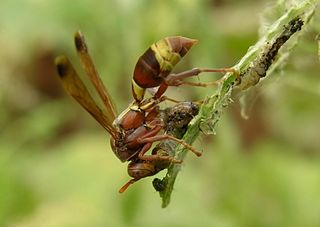
Polistes stigma is a species of paper wasp from the Paleotropics.
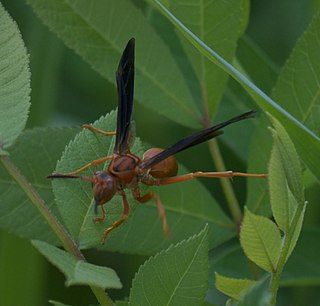
Polistes rubiginosus is one of two species of red paper wasp found in the eastern United States and is noted for the coarser ridges on its propodeum. It is a social wasp in the family Vespidae. Until taxonomic revision by Matthias Buck in 2012, P. rubiginosus was long known under the name P. perplexus. It occurs northernmost from Maryland, Pennsylvania to northern Ohio, south to Florida, and from there west to central Illinois, Kansas, Oklahoma, Texas and Arizona.

Polistes tepidus is a species of wasp in the family Vespidae. It was described by Johan Christian Fabricius in 1775. The species is endemic to parts of Oceania, primarily Indonesia, Papua New Guinea, Australia, and the Solomon Islands. Workers feed upon caterpillars to cache food for their nest. Nests are usually located in trees or other foliage but can also be found within human structures.




















